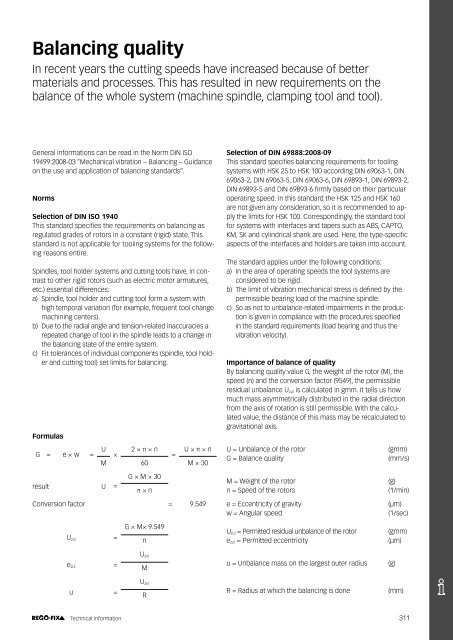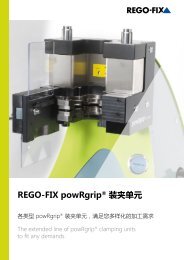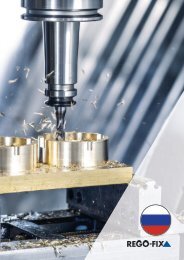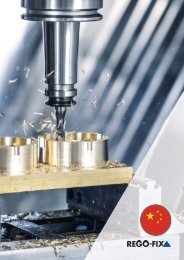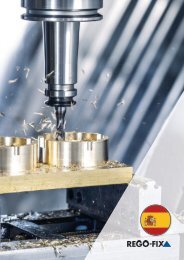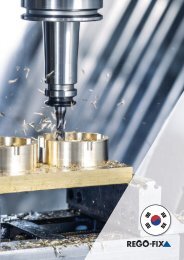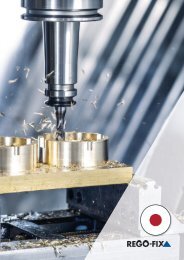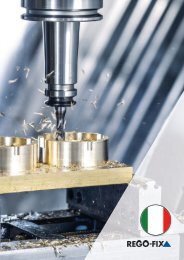REGO-FIX Main Catalogue ENGLISH
Create successful ePaper yourself
Turn your PDF publications into a flip-book with our unique Google optimized e-Paper software.
Balancing quality<br />
In recent years the cutting speeds have increased because of better<br />
materials and processes. This has resulted in new requirements on the<br />
balance of the whole system (machine spindle, clamping tool and tool).<br />
General informations can be read in the Norm DIN ISO<br />
19499:2008-03 “Mechanical vibration – Balancing – Guidance<br />
on the use and application of balancing standards“.<br />
Norms<br />
Selection of DIN ISO 1940<br />
This standard specifies the requirements on balancing as<br />
regulated grades of rotors in a constant (rigid) state. This<br />
standard is not applicable for tooling systems for the following<br />
reasons entire.<br />
Spindles, tool holder systems and cutting tools have, in contrast<br />
to other rigid rotors (such as electric motor armatures,<br />
etc.) essential differences:<br />
a) Spindle, tool holder and cutting tool form a system with<br />
high temporal variation (for example, frequent tool change<br />
machining centers).<br />
b) Due to the radial angle and tension-related inaccuracies a<br />
repeated change of tool in the spindle leads to a change in<br />
the balancing state of the entire system.<br />
c) Fit tolerances of individual components (spindle, tool holder<br />
and cutting tool) set limits for balancing.<br />
Formulas<br />
G = e × w = U ×<br />
2 × π × n<br />
=<br />
U × π × n<br />
M 60 M × 30<br />
Selection of DIN 69888:2008-09<br />
This standard specifies balancing requirements for tooling<br />
systems with HSK 25 to HSK 100 according DIN 69063-1, DIN<br />
69063-2, DIN 69063-5, DIN 69063-6, DIN 69893-1, DIN 69893-2,<br />
DIN 69893-5 and DIN 69893-6 firmly based on their particular<br />
operating speed. In this standard the HSK 125 and HSK 160<br />
are not given any consideration, so it is recommended to apply<br />
the limits for HSK 100. Correspondingly, the standard tool<br />
for systems with interfaces and tapers such as ABS, CAPTO,<br />
KM, SK and cylindrical shank are used. Here, the type-specific<br />
aspects of the interfaces and holders are taken into account.<br />
The standard applies under the following conditions:<br />
a) In the area of operating speeds the tool systems are<br />
considered to be rigid.<br />
b) The limit of vibration mechanical stress is defined by the<br />
permissible bearing load of the machine spindle.<br />
c) So as not to unbalance-related impairments in the production<br />
is given in compliance with the procedures specified<br />
in the standard requirements (load bearing and thus the<br />
vibration velocity).<br />
Importance of balance of quality<br />
By balancing quality value G, the weight of the rotor (M), the<br />
speed (n) and the conversion factor (9549), the permissible<br />
residual unbalance U zul is calculated in gmm. It tells us how<br />
much mass asymmetrically distributed in the radial direction<br />
from the axis of rotation is still permissible. With the calculated<br />
value, the distance of this mass may be recalculated to<br />
gravitational axis.<br />
U = Unbalance of the rotor<br />
G = Balance quality<br />
(gmm)<br />
(mm/s)<br />
result U =<br />
G × M × 30<br />
π × n<br />
M = Weight of the rotor<br />
n = Speed of the rotors<br />
(g)<br />
(1/min)<br />
Conversion factor = 9.549 e = Eccentricity of gravity<br />
w = Angular speed<br />
(µm)<br />
(1/sec)<br />
U zul =<br />
G × M× 9.549<br />
n<br />
U zul = Permitted residual unbalance of the rotor<br />
e zul = Permitted eccentricity<br />
(gmm)<br />
(µm)<br />
e zul =<br />
U zul<br />
u = Unbalance mass on the largest outer radius (g)<br />
M<br />
u =<br />
U zul<br />
R = Radius at which the balancing is done (mm)<br />
R<br />
Technical information<br />
311


